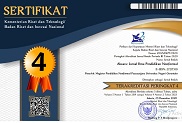Learning Activities of the of Students in Peer-Jury Practices in the Architecture Design Studio
Abstract
The students learn through critical thinking and commenting on the design works of other students. This paper aims to demonstrate the students' learning process in a peer-jury activity through both mind engagement and practical activities in the architecture design studio. The methodology of the research was based on qualitative methods with the application of semi-structured observation, photography, sketching, and graphical analysis techniques. The findings of the analysis reveal that the students participated in the peer-jury activity with five attitudes including passive, reactive, active, interactive, and engaged. The peer-jury groups’ applied four approaches to comment on the peer presenters' design outputs, including the design process, task response, idea of the design, and design outputs. In conclusion, the students learn through peers effectively to enhance their skills and abilities in a structured communication. The students improve critical thinking skills through practice, personalization, and communication.Â
Keywords
Full Text:
PDFReferences
Bailey, S. (2002). Student approaches to learning in fashion design: a phenomenographic study. Art, Design & Communication in Higher Education, 1(2), 81-95.
Bandura, A. (1986). Social foundations of thought and action: A social cognitive theory. Englewood Cliffs, NJ: Prentice-Hall.
Brown, R., & Renshaw, P. (2006). Positioning students as actors and authors: A chronotopic analysis of collaborative learning activities. Mind, Culture, and Activity, 13(3), 247-259. doi:10.1207/s15327884mca1303_6
Chinn, C. A. (2011). Educational psychology: Understanding students' thinking. Rutgers University: New Jersey.
Cohen, L., Manion, L., & Morrison, K. (2007). Research methods in education. New York: Routledge.
Collins, J., & Michaels, S. (2006). Speaking and writing: Discourse strategies and the acquisition of literacy. In J. Cook-Gumperz, The social construction of literacy (pp. 245-263). New York: Cambridge University Press.
Collins, W. A., & Steinberg, L. (2006). Adolescent development in interpersonal context. In W. Damon, R. Lerner, & N. Eisenberg, Handbook of child psychology: Vol. 3. Social, emotional, and personality development (pp. 1003-1067)). New York, NY: Wiley.
D'Souza, N. (2007). Design intelligences: A case for multiple intelligences in architectural design. International Journal of Architectural Research, 1(2), 15-43.
Davies, P. (2004). Don't write, just mark: the validity of assessing student ability via their computerized peer-marking of an essay rather than their creation of an essay. ALT-J; Research in Learning Technology, 12(3), 261-277. doi:10.1080/0968776042000259573
Double, K. S., McGrane, J. A., & Hopfenbeck, T. N. (2020). The impact of peer assessment on academic performance: A meta-analysis of control group studies. Educational Psychology Review, 32, 481-509. doi:10.1007/s10648-019-09510-3
Drexler, A. (1975). The architecture of the Ecole des Beaux-Art. New York: The Museum of Modern Art.
Frankfort-Nachmias, C., Nachmias, D., & DeWaard, J. (2014). Research methods in the social sciences (8 Ed.). New York: SAGE Publisher Ink.
Greenwood, C. R., Maheady, L., & Delquadri, J. (2002). Classwide peer tutoring programs. In M. R. Shinn, H. M. Walker, & G. Stoner, Interventions for academic and behavior problems II: Preventive and remedial approaches (pp. 611-649). Bethesda, MD.
Groat, L., & Wang, D. (2002). Architectural research methods. New York: John Wiley & Sons INC.
Guerrero, L. (2006). Nonverbal communication in close relationships. Mahwah, NJ: Erlbaum.
Hamalainen, H., Hyyrynen, V., Ikonen, J., & Porras, J. (2011). Applying peer-review for programming assignments, international. Journal on Information Technologies & Security, 1, 3-17.
Hancock, J. (1995). The interpretive turn: Radical hermeneutics and the work of architecture. ACSA Annual Meeting History Theory Criticism, (pp. 183-188). New York.
Hemyari, C., Zomorodian, K., Ahrari, I., Tavana, S., Parva, M., Pakshir, K., . . . Sahraian, A. (2013). The mutual impact of personality traits on seating preference and educational achievement. European Journal of Psychological Education, 28, 863-877.
Ion, G., Barrera-Corominas, A., & Tomà s-Folch, M. (2016). Written peer-feedback to enhance students' current and future learning. International Journal of Educational Technology in Higher Education, 13(15), 1-11. doi:10.1186/s41239-016-0017-y
Iyer, A., & Roberts, A. (2014). A phenomenographic study in understanding architecture students' approaches to learning the coursework of architectural design. Journal for Education in the Built Environment, 9(1), 89-109. doi:10.11120jebe.2014.00010
Lang, j. (1987). Creating architectural theory: The role of the behavioural sciences in environmental design. New York: Van Nostrand Reinhold.
Laroche, D. (2008). The relationship between the Beaux-Arts school and the French school at Athens. 100 years with Danish architect at l'École française d'Athènes, Monographs of the Danish Institute at Athens. 13, pp. 11-17. Athens: Danish Institute at Athens.
Laseau, P. (2000). Graphic thinking for architects and designers (3 Ed.). New York: Wiley.
Lawson, B. (2005). How designers think: The design process demystified (4 Ed.). Oxford: Oxford Press.
Lee, S. W. (2005). Encyclopaedia of school psychology. Thousand Oaks, California: Sage Publications.
Littmann, W. (2000). Assault on the Ecole: Student campaigns against the Beaux Arts, 1925-1950. Journal of Architectural Education, 53(3), 159-166.
Madanovic, M. (2018). Persisting Beaux-Arts practices in architectural education: History and theory teaching at the Auckland school of architecture, 1927-1969. Interstices Auckland School Centenary Special Issue, 9-24.
Marshall, C., & Rossman, G. B. (2006). Designing qualitative research. New York: SAGE Publications.
McClean, D., & Hourigan, N. (2013). Critical dialogue in architecture studio: Peer interaction and feedback. Journal for Education in the Built Environment, 8(1), 35-57. doi:10.11120/jebe.2013.00004
Mindrup, M. (2014). Translations of material to technology in Bauhaus architecture. Wolkenkuckucksheim Internationale Zeitschrift zur Theorie der Architektur, 19(33), 161-172. Retrieved from cloud-cuckoo.net/fileadmin/issues_en/issue_33/article_mindrup.pdf
Moore, C., & Teather, S. (2013). Engaging students in peer review: Feedback as learning. Issues in Educational Research, 23(2), 196-211. Retrieved from https://ro.ecu.edu.au/ecuworks2013/9
Moreno, R. (2010). Educational psychology. Hoboken, NJ: John Wiley & Sons, Inc.
Mulder, R. A., Pearce, J. M., & Baik, C. (2014). Peer review in higher education: Student perceptions before and after participation. Active Learning in Higher Education, 15(2), 157-171. doi:10.1177/1469787414527391
Neill, S. (1991). Classroom nonverbal communication. New York: Routledge.
Neuman, W. L. (2006). Social research methods: Qualitative and quantitative approaches. London: Pearson Education, Ink, Fifth Edition.
Niezabitowska, E. D. (2018). Research methods and techniques in architecture. New York: Routledge.
Orindaru, A. (2015). Changing perspectives on students in higher education. In P. E. Finance (Ed.), 22nd International Economic Conference - IECS 2015 “Economic Prospects in the Context of Growing Global and Regional Interdependenciesâ€, IECS 2015. 27, pp. 682 - 691. Elsevier.
Perkins, D. N., Jay, E., & Tishman, S. (1993). New conceptions of thinking: From ontology to education. Educational Psychologist, 28, 67-85.
Salkind, N. J. (2008). Encyclopaedia of educational psychology. London: SAGE Publications Ltd.
Seifert, K., & Sutton, R. (2009). Educational psychology. Zurich, Switzerland: The Global Text Project.
Silva, E. A. (2014). Quantitative methods' expertise - a diverse landscape in Europe and around the world. In E. A. Silva, P. Healey, N. Harris, & P. V. Broeck, The Routledge handbook of planning research methods (pp. 251-254). New York: Routledge.
Silverman, D. (2004). Qualitative research: Theory, method and practice. New York: SAGE Publications Ltd.
Smith, C. (2011). Understanding students' views of the crit assessment. Journal for Education in the Built Environment, 6(1), 44-67.
Tafahomi, R. (2020). Educational outcome of students' group-table arrangement for collaboration in architectural thesis studio. LWATI: A Journal of Contemporary Research, 17(2), 22-46.
Tafahomi, R. (2021). Effects of the wall-faced seating arrangement strategy on the behavioural patterns of the students in the architecture thesis design studio. Asian Journal of Assessment in Teaching and Learning, 11(1), 85-97. doi:10.37134/ajatel.vol11.1.8.2021
Tafahomi, R. (2021). Qualities of the green landscape in primary schools, deficiencies and opportunities for health of the pupils. J. Fundam. Appl . Sci, 13(2), 1093 -1116. doi:10.43 14/jfas.v13i2.25
Tafahomi, R., & Nadi, R. (2016). Modelling of thought in creation designing concept in urban design studio training. Prime Research on Education (PRE), 5(2), 821-828.
Tafahomi, R., & Nadi, R. (2020). Derivation of a design solution for the conservation of a historical Payab in the redevelopment of Doloeei, Gonabad. International Journal of Built Environment and Sustainability, 7(1), 1-9. doi:10.11113/ijbes.v7.n1.407
Tafahomi, R., & Nadi, R. (2020). Insight into the missing aspects of therapeutic landscape in psychological centers in Kigali, Rwanda. Cities & Health, 1-13. doi:10.1080/23748834.2020.1774035
Tucker, R., & Reynolds, C. (2006). The impact of teaching models, group structures and assessment modes on cooperative learning in the student design studio. Journal for Education in the Built Environment, 1(2), 39-56.
Vaus, D. d. (2002). Surveys in social research (5 ed.). Crows Nest NSW, Australia: Routledge.
Williams, M., & Robert, L. B. (1997). Psychology for language teachers. Cambridge: Cambridge University Press.
Woolfolk, A. (2016). Educational psychology. Boston: Pearson.
Xi, L., Yuan, Z., YunQui, B., & Chiang, F.-K. (2017). An investigation of university students' classroom seating choices. Journal of Learning Spaces, 6(3), 13-22.
Yang, Z., Becerik-Gerber, B., & Mino, L. (2013). A study on student perceptions of higher education classrooms: Impact of classroom attributes on student satisfaction and performance. Building & Environment, 70(15), 171-188.
DOI: http://dx.doi.org/10.37905/aksara.7.3.795-814.2021
Refbacks
- There are currently no refbacks.
Copyright (c) 2021 Aksara: Jurnal Ilmu Pendidikan Nonformal

This work is licensed under a Creative Commons Attribution-ShareAlike 4.0 International License.
Publisher:
Magister Pendidikan Nonformal Pascasarjana Universitas Negeri Gorontalo
Jl. Soedirman No. 06 Gorontalo 96128 e-mail: jurnalaksara@ung.ac.id
http://ejurnal.pps.ung.ac.id







